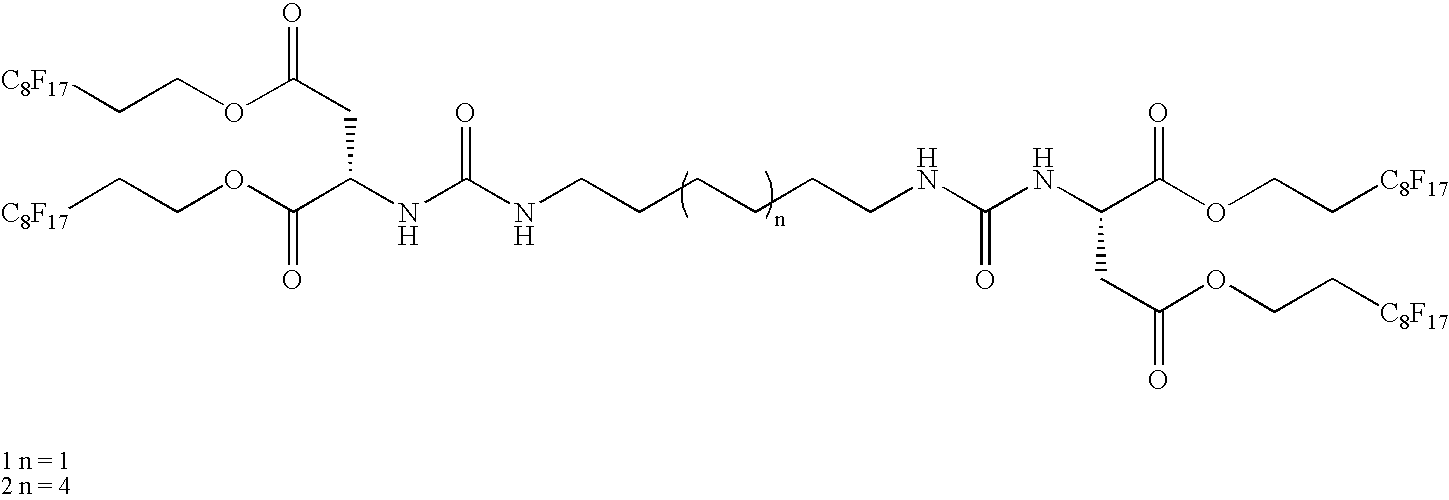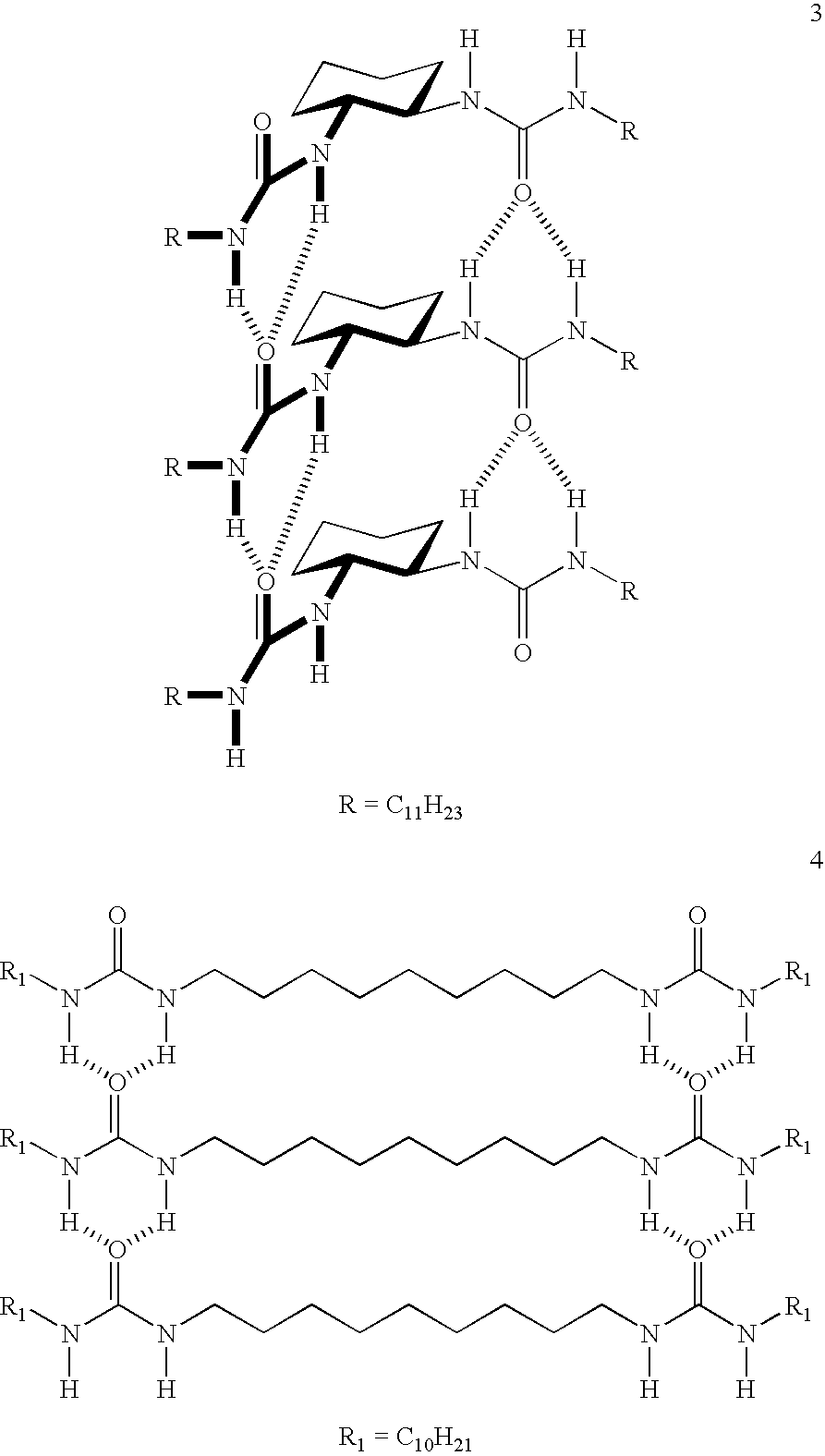Thermoreversible organogelators, compositions and methods of making thereof
a technology of organogelators and compositions, applied in the field of thermoreversible organogelators, bisurea compounds, can solve the problems of gel collapse, no longer thermoreversible, disruptable or thermoreversible,
- Summary
- Abstract
- Description
- Claims
- Application Information
AI Technical Summary
Benefits of technology
Problems solved by technology
Method used
Image
Examples
example 1
Synthesis and Characterization of Two C10-Tailed Bis-urea Organogelators (Two Compounds where R is C10 Alkyl)
[0063] Two bis-urea organogelator molecules of the formula [(3,5-OR)C6H3(CH2NHC(═O)NH)]2X where R=C10H21 and X=C6H12 or C12H24 were synthesized. The compounds were synthesized by the methyl esterification of 3,5-dihydroxybenzoic acid under acidic conditions (81% yield). The phenols on the synthesized ester were alkylated with 1-bromododecane (72% yield). The methyl ester functional group was then reduced to a benzyl alcohol using lithium aluminum hydride in good yield (81%). The alcohol was subsequently converted to a chloride (71% yield) and then an azide (80% yield). The benzyl azide was reduced to a benzyl amine in excellent yield (97%) by catalytic hydrogenation. Treatment of 1,6-diisocyanatohexane and 1,12-diisocyanatododecane with excess amine generated the bis-urea compounds (70% and 65% yield respectively). The critical concentrations (CC) for the gelation of a wide ...
example 2
Synthesis and Characterization of Two C12-Tailed Bis-urea Organogelators (Two Compounds Where R is C12 Alkyl)
[0064] Two bis-urea organogelator molecules of the formula [(3,5-OR)C6H3(CH2NHC(═O)NH)]2X where R=C12H25 and X=C6H12 or C12H24 were synthesized. The compounds were synthesized starting from the alkylation of methyl 3,5-dihydroxybenzoate with 1-bromododecane (94% yield). The methyl ester functional group was then reduced to a benzyl alcohol using lithium aluminum hydride in excellent yield (94%). The alcohol was subsequently converted to a chloride and then an azide without isolation of the intermediate chloride. This significantly improved the overall yield of the azide over previous methods (88% yield). The benzyl azide was reduced to a benzyl amine in excellent yield (97%) by catalytic hydrogenation. Treatment of 1,6-diisocyanatohexane and 1,12-diisocyanatododecane with excess amine generated the bis-urea compounds (80% and 82% yield, respectively). The critical concentrat...
example 3
Synthesis of Methyl 3,5-dinonyloxy Benzoate
[0066] In a 1 L round bottom flask (RBF) containing a stir bar and dimethylformamide (DMF); methyl 3,5-dihydroxylbenzoate (15 g, 89.2 mmol), potassium carbonate (37 g, 0.2677 M), 1-bromononane (37.36 ml, 0.1658 M), and DMF (100 mL) were added. The reaction was sealed with a septum and stirred overnight. By the end of the reaction period (15 hours), the reaction had turned from a pale yellow suspension to a dark green suspension. The dark green reaction mixture was then added to 1 L of distilled water and ice. When the ice melted, the mixture was extracted 4 times with ether (300 mL). The ether layers were combined, dried with magnesium sulfate and gravity filtered. The solvent was removed under reduced pressure. The resulting oil was then diluted with about 800 mL methanol and heated on a hotplate for 1 hour on medium heat. The mixture was allowed to cool slowly overnight. The mixture was placed in a refrigerator for 1 hour and then the to...
PUM
| Property | Measurement | Unit |
|---|---|---|
| melting temperature | aaaaa | aaaaa |
| melting temperature | aaaaa | aaaaa |
| melting temperature | aaaaa | aaaaa |
Abstract
Description
Claims
Application Information
 Login to View More
Login to View More - R&D
- Intellectual Property
- Life Sciences
- Materials
- Tech Scout
- Unparalleled Data Quality
- Higher Quality Content
- 60% Fewer Hallucinations
Browse by: Latest US Patents, China's latest patents, Technical Efficacy Thesaurus, Application Domain, Technology Topic, Popular Technical Reports.
© 2025 PatSnap. All rights reserved.Legal|Privacy policy|Modern Slavery Act Transparency Statement|Sitemap|About US| Contact US: help@patsnap.com



